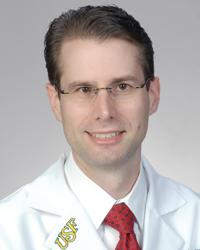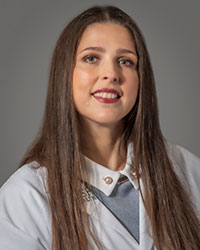Dermatology & Cutaneous Surgery
Mohs Surgery
Mohs micrographic surgery is a specialized, highly effective method for the complete removal of skin cancer. This procedure is named in honor of Dr. Frederic Mohs who created the technique. Mohs surgery differs from other skin cancer treatments in that it permits the comprehensive microscopic examination and mapping of the removed tissue to ensure complete removal of all cancerous cells and the tissue is cancer free.
USF Health leads this region’s Mohs surgery care. As part of an academic medical center, we are able to provide the newest advancements in Mohs surgery.
What We Treat
- Skin Cancer
- Basal Cell Carcinoma
- Squamous Cell Carcinoma
- Other Rare Tumors
Frequently Asked Questions
-
Mohs micrographic surgery was developed in the 1930s by Dr. Frederic Mohs as an innovative technique for completely removing certain skin cancers, such as basal and squamous cell carcinomas. Mohs surgery differs from other skin cancer treatments in that it allows for complete microscopic examination and mapping of the removed tissue to ensure removal of all cancerous cells. The result is a cure rate that is nearly 100 percent for skin cancers that have not been treated before.
-
By using complete microscopic control and mapping, the exact location of the skin cancer can be detected and removed. This includes the removal of any extensions or roots of the cancer below the skin that may be invisible to the naked eye. This technique results in the highest possible cure rate and the removal of as little normal skin as possible.
-
Eat your normal breakfast the day of surgery. Continue any medications prescribed by your doctor. However, you should inform us if you are taking blood thinning medications such as aspirin, aspirin-containing products or substitutes (Advil, Motrin, ibuprofen, etc.), Vitamin E, gingko, garlic, ginseng or other herbal supplements. These medications and supplements can prolong bleeding or have other unwanted side effects. Please avoid these products for one week prior to surgery unless prescribed by your doctor. You may continue to take coumadin or Plavix. Please call our office with any questions. Please do not consume alcoholic beverages or use tobacco 48 hours before surgery and until your stitches are removed. In addition, please avoid wearing make-up, perfume, and jewelry the day of your surgery.
-
The procedure is begun after the area to be removed has been anesthetized with a local anesthetic. The surgeon then removes a thin layer of skin consisting of the visible tumor and a narrow rim of normal skin. A temporary bandage is placed over the site and the patient waits in the waiting room while the tissue is processed. The surgeon examines the slides prepared from the tissue with a microscope. A map is created of all tissue removed and any areas with remaining cancer are plotted on the map. The surgeon then returns to the patient to remove any remaining areas of cancer in the skin. This process is repeated until all of the cancer is removed. One to two hours are needed each time a layer of skin is processed and examined with the microscope. Skin cancers may have extensions or roots beneath the skin that are invisible to the naked eye. No one can predict how many layers will be necessary to completely remove the cancer. For this reason it is impossible to predict how large the final wound will be or how long the procedure will take. We would like to make the time you spend with us as pleasant and comfortable as possible. You should come prepared to spend the entire day with us. You should bring a bag lunch, a sweater, and perhaps some reading material to occupy your time while the slides are being processed. It is also necessary that you arrange for someone other than yourself to transport you to and from the doctor's office.
-
You will be given written instructions on how to care for your wound. It is very important that you follow these instructions precisely. You may experience redness, swelling, drainage, and bruising around the wound. This will decrease with time. Most patients do not complain of pain. If there is any discomfort, Tylenol is all that is usually necessary for relief. You will need to return to have the wound examined until it is healed and to have any sutures removed. Once the wound has healed you may return to your referring physician. Patients should understand that there is no guarantee that any given procedure will be completely successful or free of complications and adverse reactions. Mohs surgery is no exception. During surgery, tiny nerve endings are cut, which may produce a temporary or permanent numbness or weakness in and around the surgical area. The surgical area may remain tender for weeks or months after surgery. Some patients may experience itching or shooting pain in the surgical area. Skin grafts or flaps used to cover surgical areas, may not fully survive, requiring additional repair. The scar may feel lumpy, tight, or have a drawing sensation. This is normal and may persist but usually improves with time. Despite the high cure rate of Mohs surgery, no method is 100% effective and recurrence is possible. Therefore, your follow-up visits with your physician are very important to detect recurrence or the development of new skin cancers.
-
Yes. As with all forms of surgery a scar will remain. However, since Mohs surgery only removes as little tissue as necessary, the smaller defect results in a smaller scar. Remember, only tissue that needs to be removed is removed. The final defect is often only somewhat larger than the visible area but can occasionally result in a sizeable defect. Scars have the ability to remodel and improve in appearance for many months after surgery. There are several options to repair the wound once the cancer is removed. Some wounds may be allowed to heal on their own. Most require stitches to close the wound. Some areas of the body do not have enough skin to stretch to cover a wound and require either a skin graft or skin flap to be used. A skin graft is a technique in which skin from another location, such as behind the ear, is removed and used to cover the defect, and sewn into place. The donor site of the graft is then allowed to heal on its own or is closed with stitches. A skin flap is performed by partially freeing the neighboring skin. This borrowed skin is then moved to allow it to cover the wound. Stitches are used to secure it in place. The best management plan for your wound will be discussed with you once all of the cancer has been removed.

